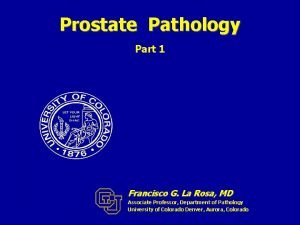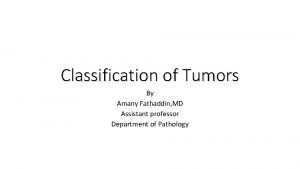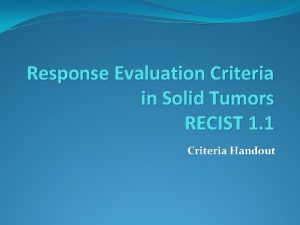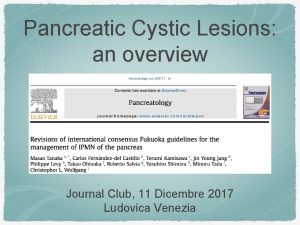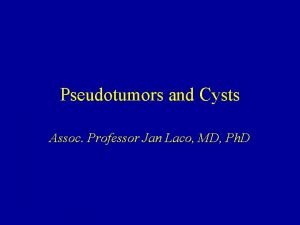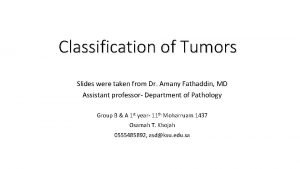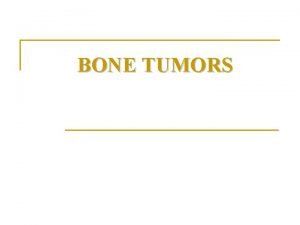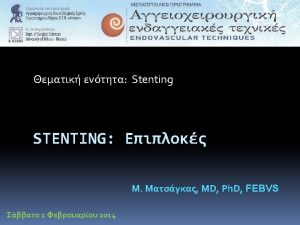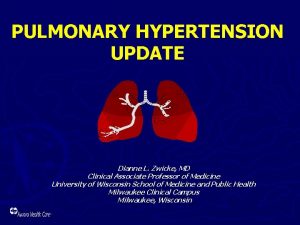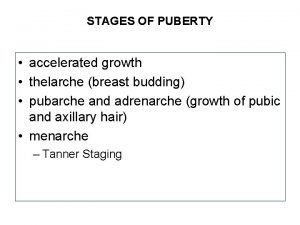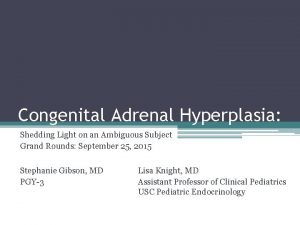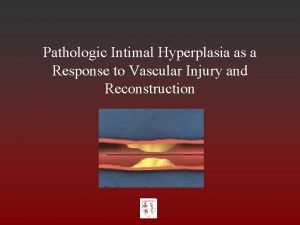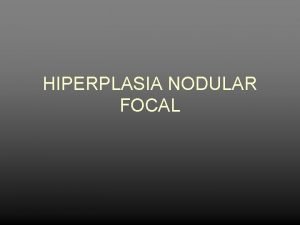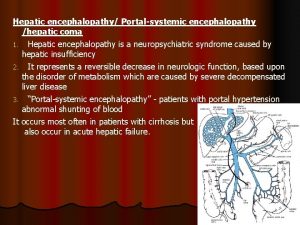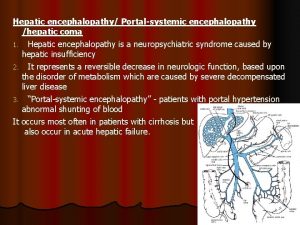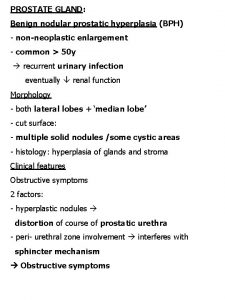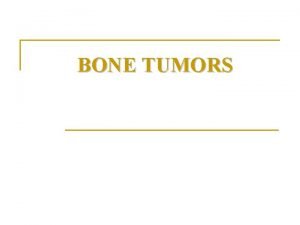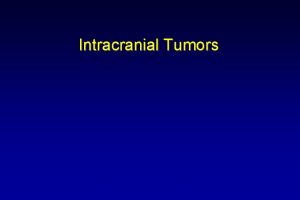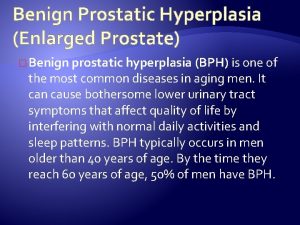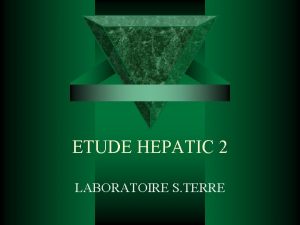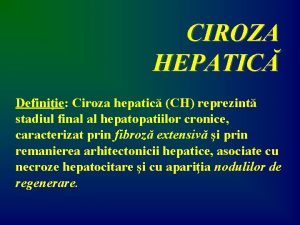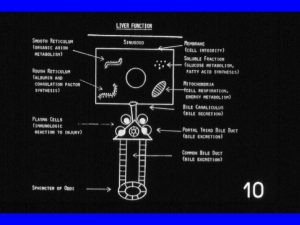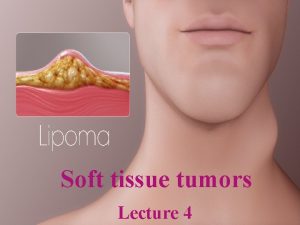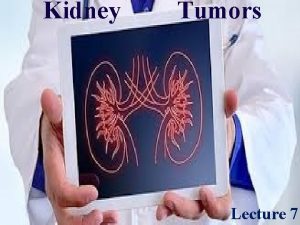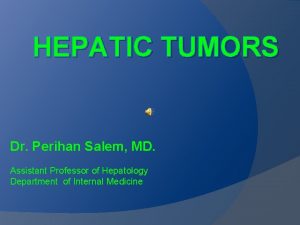Hepatic nodules Tumors Lecture 10 Focal Nodular Hyperplasia
































- Slides: 32

Hepatic nodules & Tumors Lecture 10

Focal Nodular Hyperplasia: v. Localized, well-demarcated, poorly encapsulated. v. Not a true neoplasm. v. No risk for malignancy. v. Nodules consist of: v. Hyperplasic hepatocyte with central stellate shap fibrous scar. (Star shape) Cause: (Suggestion) v. A response to abnormal blood flow Alternating areas of parenchymal regeneration & atrophy. v. Most common in women in reproductive age, growing in response to estrogens. (Female sex H. ) (Including those found in contraceptive pills).



Benign Tumors Most common: Cavernous hemangiomas: Well circumscribed lesions consist of blood vessels & intervening stroma. Gross: Red-blue, soft nodules. Less than 2 cm in diameter.


Hepatic Adenoma: Benign neoplasm. v. Occurs in women in child-bearing age who have used oral contraceptive pills. v. Regress by discontinuity of hormone use. v. Well demarcated lesion. v. Not encapsulated tumors. v. Pale, yellow-tan, or bile-stained.

Histologic examination: v. Sheets & cords of cells. v. Resemble normal hepatocytes. v. Or have minimal variation in cell & nuclear size. v. Portal tracts are absent. (Loss of normal architecture). v. Prominent arterial vessels & draining veins.

Hepatic malignancies: 1 - Primary hepatic malignancies: Most common is hepatocellular carcinomas. 2 - Metastatic cancers: q Liver is most commonly involved by metastatic cancers. q Most common metastatic hepatic neoplasm are carcinomas from colon, lung, & breast.

Hepatocellular Carcinomas: Hepatoma: Three major etiologic associations: v 1 - Infection with HBV or HCV. Chronic HCV infection is the most important risk factor in development of liver cancer. . v 2 - Alcoholic cirrhosis: 90% of cases develop cancer v 3 - Aflatoxin exposure: v. Carcinogenic toxins found in moldy grains & peanuts that results in mutations.

Morphology: Gross: (1) Unifocal massive tumor. (2) Multifocal tumor nodules of variable size. (3) Diffusely infiltrative cancer involving the entire liver, blending into the cirrhotic background. Tumor masses: v. Yellow white. v. Or bile staining & hemorrhage or necrosis. v. Soft in consistency because of little C. T. stroma in most hepatocellular carcinomas.


Histologic examination: 1 - Well differentiated lesions: Hepatocytes arranged in cords, trabeculae or glandular patterns with globules of bile found within the cytoplasm of cells.

Well-differentiated hepatocellular carcinoma: Distortions of normal structures: Liver cell plates are markedly widened & frequent pseudoacinar structures (arrows)—abnormal bile canaliculi contain bile.

2 - Poorly differentiated lesions: Composed of large, multinucleate anaplastic giant cells.

Disorders of gallbladder & extrahepatic biliary tract Gallbladder diseases: 1. 95% of these diseases: Cholelithiasis =Gallstones. 2 - Cholecystitis: Inflammation. 3 - Tumors of biliary tract: Cholangiocarcinoma.

Cholelithiasis (Gallstones): Two main types of gallstones: 1 - Cholesterol stones: q Composed of cholesterol. q Formed when there is cholesterol supersaturation (Increase concentrations) 2 - Pigment stones: q Made of bilirubin calcium salts. q Form due to the presence of unconjugated bilirubin in biliary tree. (In hemolytic anemia).

1. Cholesterol stones: Morphology: v. Arise exclusively in gallbladder. v. Consist of 50 -100% cholesterol Pale yellow. v. Increasing proportions of calcium carbonate, phosphates & bilirubin Gray-white to black. v. Ovoid & firm. v. Occur singly, but most often are numerous. v. Most cholesterol stones are radiolucent in X-ray. v 20% have sufficient calcium carbonate to appear radiopaque. v. Gallbladder mucosa: Redness due to acute & chronic cholecystitis.


2. Pigment stones: v. Arise anywhere in the biliary tree. v. Contain calcium salts of unconjugated bilirubin & lesser amounts of other calcium salts, mucin, glycoproteins, & cholesterol. Classified into: 1. Black stones. 2. Brown stones.

1 - Black stones: # Found in sterile gallbladder. (Not infected) # Small in size, fragile to touch & numerous. # 50 -75% appears as radiopaque. (Because of calcium carbonates & phosphates).

2 - Brown stones: # Found in infected intra- or extra-hepatic ducts. # Soft, greasy, soap like consistency (radiolucent). # Results from retained fatty acid salts.

Clinical Features: ØAsymptomatic throughout life in 70 -80%. ØSymptoms are striking in unfortunate minority. Sever biliary pain, localizes at the right upper quadrant or epigastric region, constant or, less commonly, spasmodic. Pain is caused by: 1. Obstruction of gallbladder or biliary tree. 2. Or by inflammation of gallbladder itself. More severe complications: Empyema, perforation, fistulas, infl. of biliary tree & obstructive cholestasis or pancreatitis.

Cholecystitis v. Inflammation of gallbladder. v. Always occurs in association with gallstones. v. Acute, chronic, or acute superimposed on chronic. Morphology: Acute cholecystitis: v. Gallbladder: v. Enlarged, . v. Tense. v. Bright red or motteled violaceous color due to subserosal Hg.

Serosa: Covered by fibrinous or fibrinopurulent exudate. Lumen: Filled with cloudy or turbid bile contain fibrin, blood & pus (Empyema) Wall: Thickened, edematous & hyperemic. In more severe cases: Gallbladder is transformed into green-black necrotic organ: Gangrenous cholecystitis. v. Histologic examination: v. Inflammatory reactions: Acute inflammation: v. Edema, leukocytic infiltration, congestion, frank abscess formation, or gangrenous necrosis.



Morphology of chronic cholecystitis: v. Presence of stones within gallbladder. v. Gallbladder: v. Contracted, normal size or enlarged. v. Submucosa & subserosa: Thickened by fibrosis. Clinical Features: Acute cholecystitis: q. Sever biliary pain: q. Steady, upper abdominal in location. q. Radiates to right shoulder. q. Fever & nausea. q. Leukocytosis & intolerance for fatty foods.


Tumors: Carcinoma of Gallbladder: v. Most common malignant tumor of biliary tract. v. Cause: Gallstones: v. Present in 60 -90% of cases Recurrent trauma & chronic inflammation Cancer. v 1. Adenocarcinoma: Most common type. v 2. Squamous cell carcinomas: 5%. Morphology: 1 -Exophytic mass: Grows into lumen as cauliflower like mass & also invades the underlying wall. 2 -Infiltrating growth causing diffuse thickening & induration of gallbladder wall. (Loss of elasticity due to fibrosis)

Adenocarcinoma of gallbladder. Opened gallbladder contains a large, exophytic tumor fills the lumen & Glandular structures histologically.

Thank you
 Nodular hyperplasia
Nodular hyperplasia Odontogenic tumors
Odontogenic tumors Classification of tumors
Classification of tumors Spinal cord tumors
Spinal cord tumors Liposarcoma
Liposarcoma Response evaluation criteria in solid tumors (recist)
Response evaluation criteria in solid tumors (recist) Ameloblastoma rtg
Ameloblastoma rtg Brain tumors
Brain tumors Classification of testicular tumors robbins
Classification of testicular tumors robbins Exocrine tumors of pancreas
Exocrine tumors of pancreas Odontogenic tumors classification
Odontogenic tumors classification Bone tumors
Bone tumors Ata thyroid
Ata thyroid Chest wall tumors
Chest wall tumors Cervical ectropion
Cervical ectropion Classification of tumors
Classification of tumors Enneking staging
Enneking staging Exostosis
Exostosis 60% of15
60% of15 Malignant and benign tumors
Malignant and benign tumors Intimal hyperplasia
Intimal hyperplasia Intimal hyperplasia
Intimal hyperplasia Congenital adrenal hyperplasia characteristics
Congenital adrenal hyperplasia characteristics Gallbladder histology drawing
Gallbladder histology drawing Sebaceous hyperplasia
Sebaceous hyperplasia Gingival hyperplasia
Gingival hyperplasia Hyperplasia
Hyperplasia Non classical adrenal hyperplasia
Non classical adrenal hyperplasia Types of cell injury
Types of cell injury Fundus mirigy hyperplasia
Fundus mirigy hyperplasia Intimal hyperplasia
Intimal hyperplasia Feminization tubes
Feminization tubes Hyperplasia and hypertrophy difference
Hyperplasia and hypertrophy difference
